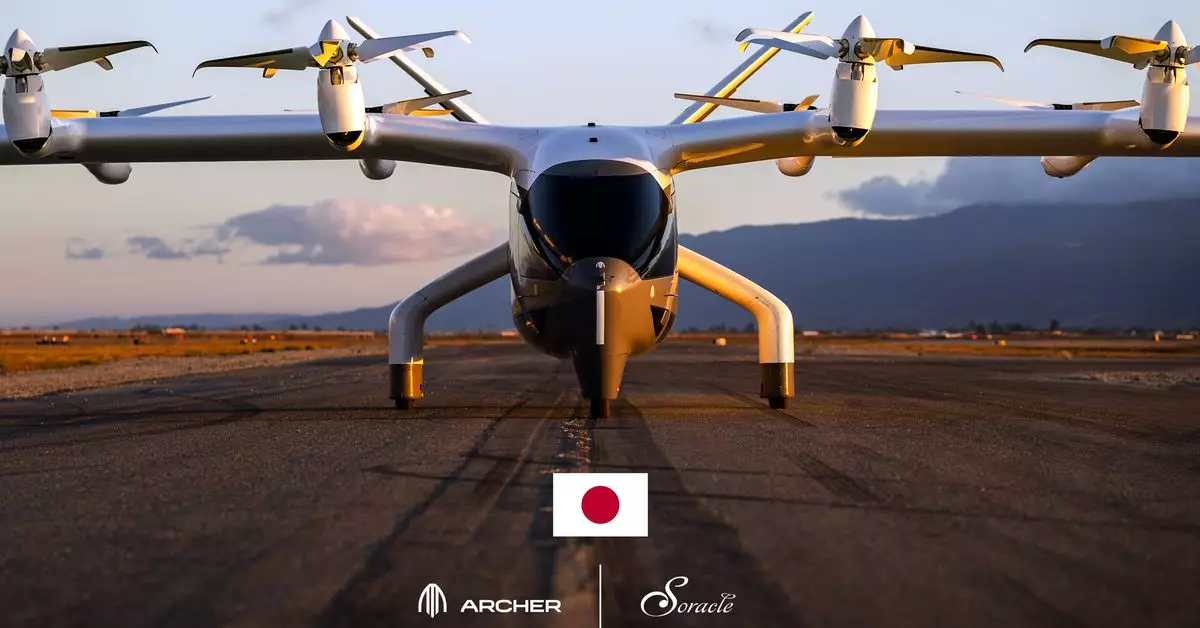The advent of electric aviation is poised to dramatically change the way we navigate urban landscapes, and Archer Aviation is at the forefront of this revolutionary movement. Based in San Jose, California, Archer is bringing its innovative air taxi, the Midnight, to Japan in a notable collaboration with Soracle, a joint venture formed by Japan Airlines and Sumitomo Corporation. Valued at approximately $500 million, this deal signifies Archer’s growing international footprint and ambition to redefine urban mobility.
The Midnight is unlike any existing form of transportation. Designed to look like a hybrid between a drone and a helicopter, the air taxi is engineered for urban environments, particularly where traditional ground transport faces limitations due to congestion or geographic challenges. With a capacity of four passengers plus one pilot, the Midnight can cover distances up to 100 miles on a single charge, though it is specifically optimized for shorter, efficient trips of 20 to 50 miles. This remarkable design not only emphasizes speed—up to 150 mph—but also employs tilt rotor technology, allowing it to take off and land vertically before transitioning into forward flight.
Establishing a new mode of transport involves more than just groundbreaking technology; it requires navigating complex regulatory landscapes. Archer aims to collaborate closely with Soracle and the Japanese Civil Aviation Bureau (JCAB) to secure the necessary permissions and certifications for operational deployment. This strategy is vital, as Archer must reach specific milestones before Soracle commits to pre-delivery payments. The reference to “certain milestones” underscores the caution with which both parties are proceeding, ensuring that safety and regulatory compliance are paramount.
Archer’s focus on regulatory certification is exemplified by its recent achievement of a Part 135 air carrier certification from the U.S. Federal Aviation Administration (FAA). This foundational step is crucial for operating an on-demand air taxi service within the U.S. Furthermore, Archer is in the process of obtaining a type certification for the Midnight. This validation ensures that the aircraft aligns with the FAA’s safety and design benchmarks, an essential hurdle for any aviation enterprise seeking to enter the nascent air taxi market.
Investment Confidence amid Industry Challenges
Despite facing a landscape fraught with competition and uncertainty, Archer appears to be riding a wave of optimism. They have secured a substantial order of $1 billion from United Airlines, along with partnerships for mass production with the global automotive giant Stellantis. Meanwhile, some competitors in the eVTOL space are experiencing setbacks—Lilium, a German firm, has recently reported insolvency within its subsidiaries, highlighting the inherent risks of this high-stakes industry.
With the FAA’s recent unveiling of comprehensive final regulations for eVTOL vehicles, the agency has signaled a commitment to facilitating future air travel, boosting the confidence of players like Archer. The clear framework establishes critical guidelines for the safe operation of eVTOL aircraft in the United States, which can only bolster the market’s overall growth potential.
It is essential to clarify a frequent misconception prevalent in mainstream media: air taxis are often inaccurately dubbed “flying cars.” In reality, these vehicles are more akin to advanced helicopters, minus the combustion engines that produce noise and pollution. However, they bring their own unique sound characteristics and operational challenges that will need to be addressed as they proliferate in urban airspace.
Archer Aviation is not alone in this venture; competitors like Joby Aviation and Volocopter are also racing to launch their air taxi services on a national scale. With regulatory advances and a wave of public interest in sustainable transportation solutions, the future of urban mobility is likely to be dominated by eVTOL technologies that promise to alleviate traffic woes.
As Archer Aviation prepares to deploy its Midnight air taxis in Japan, it embarks on a journey that could reshape urban mobility around the globe. Through strategic partnerships, stringent adherence to regulatory approvals, and a commitment to innovative design, the groundwork is being laid for a future where air taxis could become a commonplace component of our transportation ecosystem. The transition to electric vertical takeoff and landing vehicles represents not merely a technological advancement but a cultural shift in how we think about transport and urban planning. The dream of soaring over the congested streets may soon become a reality, heralding a new chapter in the way humanity connects.


Leave a Reply